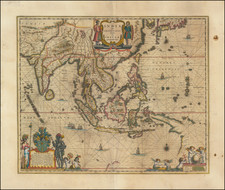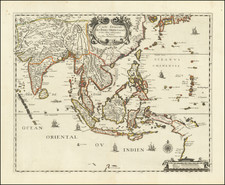A Rare French Colonial India City Map
Rare map of the city of Chandannagar in West Bengal, published by the Surveyor General of India in 1872.
The map provides an exceptionally detailed look at the city, which at the time was one of three remaining French colonies in India.
The reference key at the bottom includes keys identifying
- Masonry and Mud Houses
- High roads and foot paths
- Railways
- Masjid
- Hindu Temples
- Police Station
- River and Ferry
- Tanks
- Telegraph Lines
- Areas fit for Cultivation
Includes a pastedown label noting:
- Colored, Price Two Rupees Four Annas
- Uncolored, " One Rupee Eight Annas
Includes an illegible signature at the bottom left corner, with a March 25, 1875 date.
Chandannagar
Chandannagar was founded by the French, as a combination of several local villages, including Gondolpara to the South, Boro in the North and Khalisani to the West. The name "Chandernagore" can be first found in the letter dated 1696, intended for the officials of French East India Company, dispatched by Andre Boureau Deslandes and Palle, French officials posted in Chandernagore.
The First Director of the French East India Company, Deslandes paid 40,000 coins to the Mughal subahdar in 1688 to gain control of the area and build a factory there. But the first Frenchman to possess any subsequent land holding in this area was Du Plessis who bought land of 13 Arpents at Boro Kishanganj, now located at North Chandannagar for Taka 401 in the year 1673–74.
The Fort de Orleans was constructed in the year 1696-97 and was better defended than its French and British counterparts.
In 1730, Joseph François Dupleix was appointed governor of the city, during whose administration more than two thousand brick houses were built and a considerable maritime trade was carried on. It also attracted people from all over India who came and settled here for trade and commerce. The population of the city reached to be around a 100,000, much larger than neighboring Calcutta to the south. From Dupleix's time to 1756, Chandannagar was the main center for European commerce in Bengal, a thriving center of trade involving opium, indigo, silk, rice, rope, sugar, etc. The fine clothes of Chandannagar were exported to Europe.
In 1756, war broke out between France and Great Britain, and the British captured Chandannagar on March 23, 1757. The town's fortifications and many houses were demolished thereafter, and Chandannagar's importance as a commercial center was eclipsed by that of Calcutta. Chandernagore was restored to the French in 1763, but retaken by the British in 1794 in the Napoleonic Wars. The city was returned to France in 1816. It was governed as part of French India until 1850, under the political control of the governor-general in Pondicherry.
Rarity
OCLC lists a single example in the Bibliotheque National de France.
We note a reference to the map in the 1878 printed catalog: A Catalogue of Manuscript and Printed Reports, Field Books, Memoirs, Maps, etc., of The Indian Surveys Deposited in the Map Room of the India Office. (p. 458).









![India Forest Lands Under Government Control [with:] India Agriculture [and:] India Annual Rainfall & Temperature [and:] India Minerals](https://storage.googleapis.com/raremaps/img/small/101419.jpg)
![[ Postal Map of India ] India Shewing The Post Roads And Dawk Stations By James Wyld . . .](https://storage.googleapis.com/raremaps/img/small/99685.jpg)


![[Pakistan & India] Tabula Asiae IX](https://storage.googleapis.com/raremaps/img/small/94368.jpg)
![[Middle East, Central Asia & Indian Ocean]](https://storage.googleapis.com/raremaps/img/small/92812.jpg)